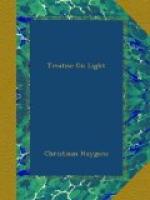To come to the properties of Light. We remark first that each portion of a wave ought to spread in such a way that its extremities lie always between the same straight lines drawn from the luminous point. Thus the portion BG of the wave, having the luminous point A as its centre, will spread into the arc CE bounded by the straight lines abc, Age. For although the particular waves produced by the particles comprised within the space CAE spread also outside this space, they yet do not concur at the same instant to compose a wave which terminates the movement, as they do precisely at the circumference CE, which is their common tangent.
And hence one sees the reason why light, at least if its rays are not reflected or broken, spreads only by straight lines, so that it illuminates no object except when the path from its source to that object is open along such lines.
For if, for example, there were an opening BG, limited by opaque bodies BH, GI, the wave of light which issues from the point A will always be terminated by the straight lines AC, AE, as has just been shown; the parts of the partial waves which spread outside the space Ace being too feeble to produce light there.
Now, however small we make the opening BG, there is always the same reason causing the light there to pass between straight lines; since this opening is always large enough to contain a great number of particles of the ethereal matter, which are of an inconceivable smallness; so that it appears that each little portion of the wave necessarily advances following the straight line which comes from the luminous point. Thus then we may take the rays of light as if they were straight lines.
It appears, moreover, by what has been remarked touching the feebleness of the particular waves, that it is not needful that all the particles of the Ether should be equal amongst themselves, though equality is more apt for the propagation of the movement. For it is true that inequality will cause a particle by pushing against another larger one to strive to recoil with a part of its movement; but it will thereby merely generate backwards towards the luminous point some partial waves incapable of causing light, and not a wave compounded of many as CE was.
Another property of waves of light, and one of the most marvellous, is that when some of them come from different or even from opposing sides, they produce their effect across one another without any hindrance. Whence also it comes about that a number of spectators may view different objects at the same time through the same opening, and that two persons can at the same time see one another’s eyes. Now according to the explanation which has been given of the action of light, how the waves do not destroy nor interrupt one another when they cross one another, these effects which I have just mentioned are easily conceived. But in my judgement they are not at all easy to explain according to the views of Mr. Des Cartes, who makes Light to consist in a continuous pressure merely tending to movement. For this pressure not being able to act from two opposite sides at the same time, against bodies which have no inclination to approach one another, it is impossible so to understand what I have been saying about two persons mutually seeing one another’s eyes, or how two torches can illuminate one another.




